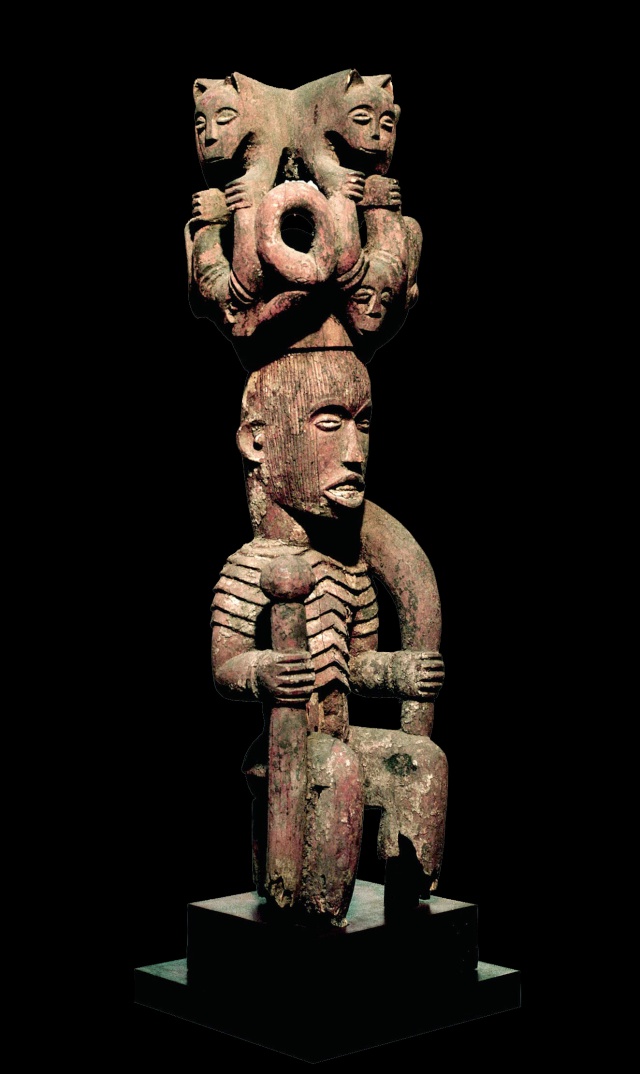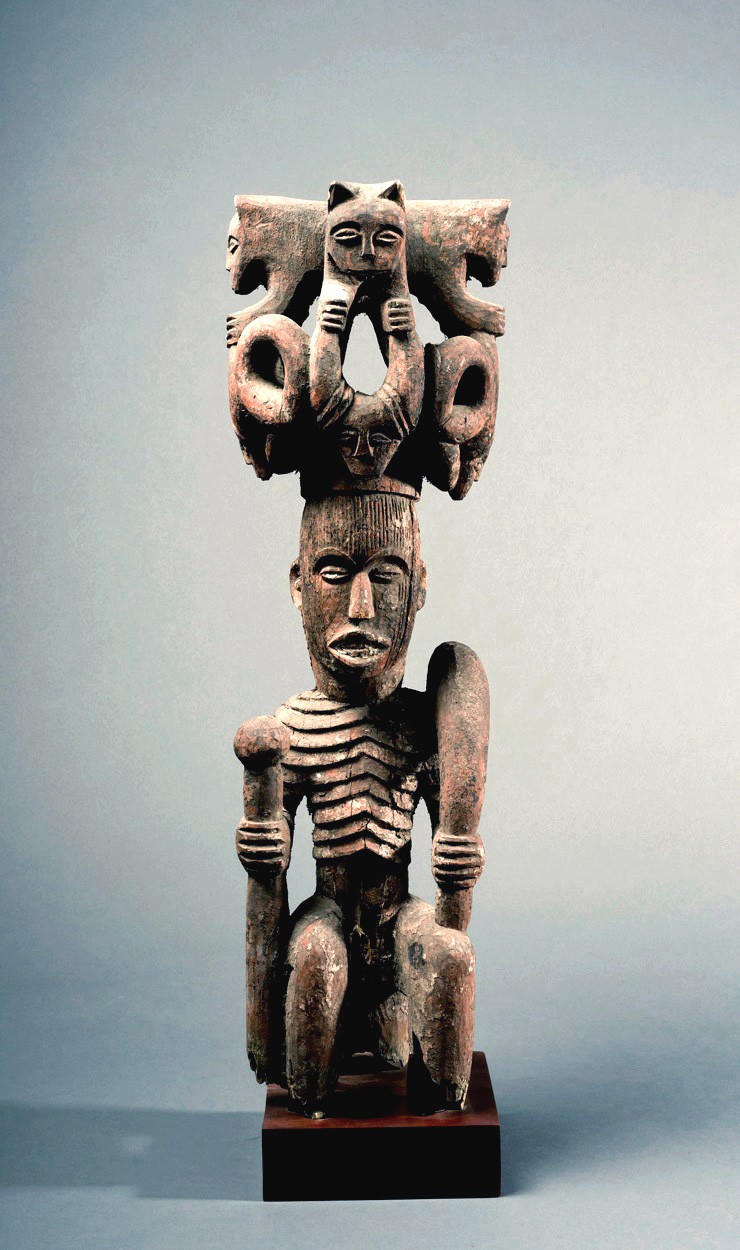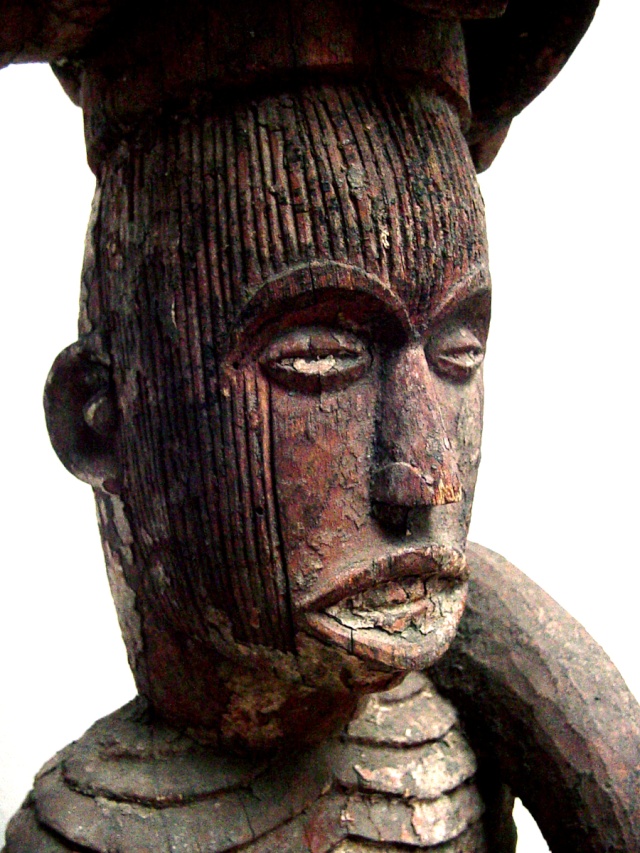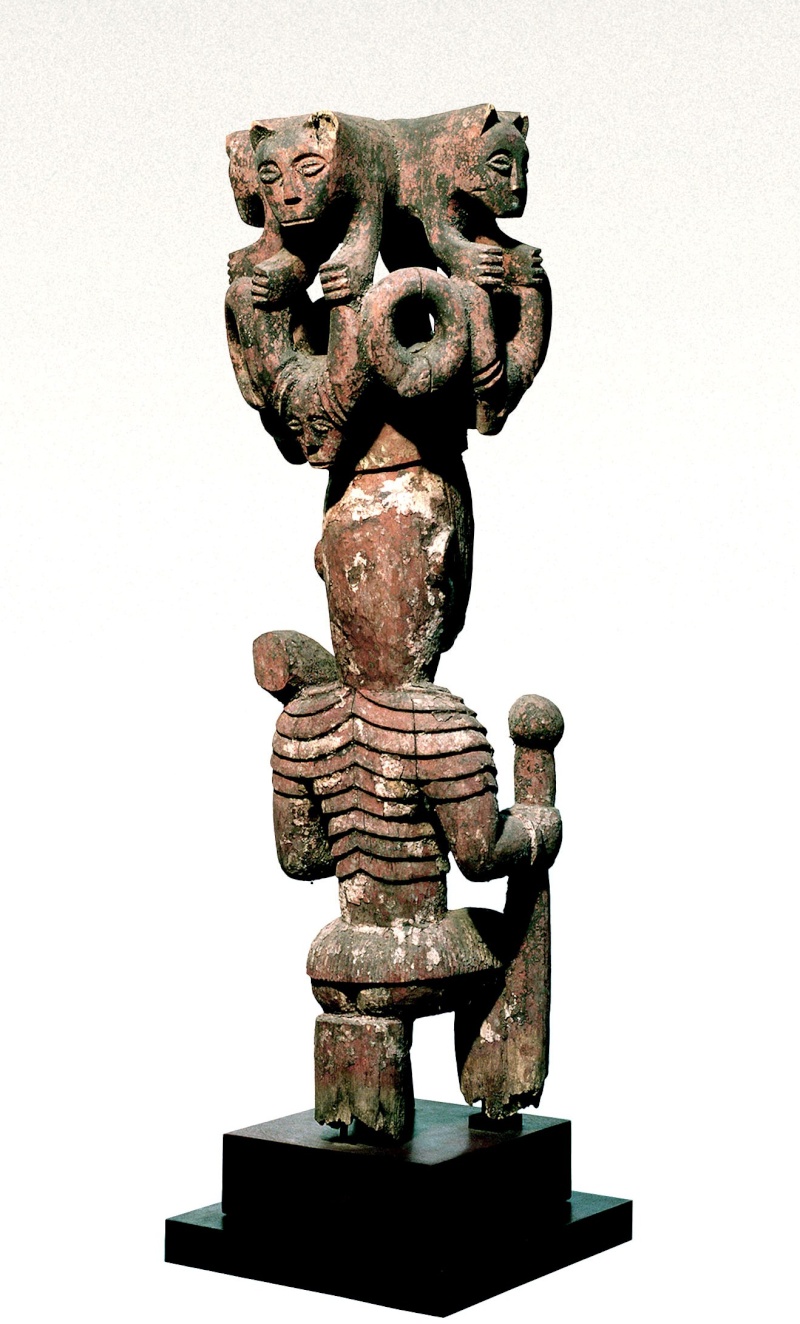Igbo people, Ikenga, Aguleri-Umuleri Area (Igboland North-West), Nigeria
Pagina 1 di 1
 Igbo people, Ikenga, Aguleri-Umuleri Area (Igboland North-West), Nigeria
Igbo people, Ikenga, Aguleri-Umuleri Area (Igboland North-West), Nigeria

Igbo People, Ikenga, Aguleri-Umuleri Area (Igboland North-West), Nigeria
23,2 in/ 59 cm,
Wood, pigment color, earthy matter
Last quarter 19th century
Private collection, Italy
Photo by David Lorente/Zoom 3000 and Alessandro Ligato
Arti delle Mani Nere All Rights Reserved
Provenance
Pons coll., Barcelona
Angel Martin Gallery, Madrid
Exhibition
-Bruneaf, 2010, Bruxelles
- L’Africa delle Meraviglie. Arti Africane nelle collezioni italiane. Museo Palazzo Ducale, Genova, 31th December 2010 – 16th March 2011
- Materia Negra, Fundacion Antonio Saura, Casa Zavala, Cuenca (Spagna ), 18 th March/ 28 th May 2011
Published
- Bargna I, e Parodi da Passano G., L'Africa delle meraviglie - Arti africane nelle collezioni italiane, Genova, 2010, Silvana Editoriale, Cinisello Balsamo (MI), pag. 155, color
-AA.VV. “Materia Negra”, Edicion Fundacion Antonio Saura, Cuenca (Spagna), 2011, pag.186, 187 color
The Ikenga statuary is generally represented within the classical iconography from
a seated figure, powerful curved horns, fierce face and the symbols of
war: knives, shield, severed head of the enemy, well in evidence.

Much rarer, however, there is another Ikenga representation , the ones of
the Warrior /King carved with symbolic attributes of his dignity: the barrel and
the elephant tusk together with the whole zoomorphic complex set and the elaborate clothing.
On a symbolic level, the King / Warrior in the Ikenga
hierarchy is set to the higher rank.
The complex zoomorphic iconography of the buffalo, leopard and snake
(well represented by an elephant's tusk) expresses the pride,
the hieratic determination and the power of the rank called Ozo. (Eli Bentor
1988, African Arts, XXI, 2, p. 66/71, 94).
The king's body is covered with a scaly armor degrading that refers to a fossil amphibian, and two bracelets encircling the wrist.
Posture is solemn, the gaze is penetrating, profound - not aggressive.
A proud king warrior designed for the high rank that the Ikenga can express.

The figure consists of three sections: headgear, head and body, that occupy the space with harmony and composure, giving at whole a sense of consistency and uniformity.
The stylistic coherency of the three elements give to the statue a balance of shapes and volumes.
There are few known sculptures of this type.
The first, most popular, is the monumental former in Kerchache collection.
A second belonged to the Baron De Grunne, and another was in Verité collection.
Also Tell Collection has one, and three similar are respectively in the British Museum of London, in Indiana University Art Museum in Bloomington and in the Boston Museum.
Finally on the book by John S. Boston "Ikenga figures amog the North-West Igbo and Igala "(1977) are reported two other of which one is dated at the beginning of the last century (p. 60 and 61).
“A considérer un corpus suffisamment étendu d'ikenga , on s'aperçoit vite que, relevant de la même aire Igbo Amuleri/Umuleri, cet exemplaire et celui de l'ancienne collection Kerchache sont à la fois formellement et iconographiquement les plus importants” ( J.L. Paudrat, private correspondence)

Bibliography
-D.Ford, G.I. Jones,” The Ibo and Ibibio. Speaking Peoples of South-Eastern Nigeria”, Oxford University press, London, 1950
-J.S. Boston, “Ikenga figures among the north-west Igbo and the Igala”, The Federal Department of Antiquites Lagos, Nigeria, London, 1977
-H.Cole, C. Anikor, “Igbo Arts. Community and Cosmos”, University of California, Los Angeles, 1984
-F. Neyt, “Les Arts de la Benue. Aux racines des traditions”, Tielt, 1985
-J. Kerchache, J.L. Paudrat, L. Stephan, “ L’art africain”, Mazenod, Paris, 1988
-AA.VV. “Arts du Nigeria”, Réunion des Musées nationaux ed., Paris,1997
-M.C. Berns, R.and K. Fardon, S. Littlefield "Central Nigeria Unmasked: Arts of the Benue River Valley" Flower Museum At Ucla, Los Angeles, 2011
Yale University Art Gallery, Numero d’archivio 0123871
Igbo , Ikenga, area di Aguleri-Umuleri ( nord/ovest Igboland), Nigeria
Cm. 59,
Legno, pigmento colore, materia terrosa
Ultimo quarto sec. XIX
Collezione privata, Italia
Foto David Lorente/Zoom 3000 ed Alessandro Ligato
Arti delle Mani Nere All Rights Reserved
Provenienza
- Coll. Pons, Barcellona
- Galleria Angel Martin, Madrid
Esposizioni
Bruneaf, 2010, Bruxelles
- L’Africa delle Meraviglie. Arti Africane nelle collezioni italiane. Museo Palazzo Ducale, Genova, 30 dicembre 2010-16 marzo 2011
-Materia Negra, Fundacion Antonio Saura, Casa Zavala, Cuenca (Spagna ), 18 marzo/ 28 maggio 2011
Pubblicazioni
Catalogo Esposizione “L’Africa delle Meraviglie. Arti Africane nelle collezioni italiane “, Silvana Editoriale, Milano, 2010, pag. 155, color
Catalogo Esposizione “Materia Negra”, Edicion Fundacion Antonio Saura, Cuenca (Spagna), 2011, pag.186, 187 color
La statuaria Ikenga è generalmente rappresentata nell’iconografia classica da
una figura assisa, potenti corna ricurve, il volto feroce, simboli della
guerra: coltello, scudo, testa recisa del nemico, ben in evidenza.
Molto più rara, esiste però un’altra rappresentazione dell’Ikenga, quella del
Re/Guerriero scolpito con gli attributi simbolici della sua dignità: la canna e
la zanna di elefante unitamente al complesso corredo zoomorfico ed all’
elaborato vestiario.
Sul piano simbolico il Re/ Guerriero occupa nella gerarchia degli Ikenga il
rango più elevato.
La complessa iconografia zoomorfica del bufalo, del leopardo e del serpente
(unitamente all’elefante rappresentato da una sua zanna), esprime la fierezza,
la determinazione ieratica e la potenza del rango denominato Ozo. (Eli Bentor
1988, African Arts, XXI, 2, pag 66/71, 94).

Il corpo del Re è rivestito da una corazza a scaglie degradanti che rimanda ad
un fossile anfibio, e due bracciali gli cingono i polsi.
La postura è solenne, lo sguardo è penetrante, profondo, per nulla aggressivo.
Un fiero Re Guerriero destinato al rango della massima
autorità che l’Ikenga può esprimere.
La figura è composta da tre sezioni Copricapo, Testa e Corpo, occupano lo
spazio con armonia e compostezza, dando all’insieme un senso di compattezza ed
unitarietà.
La coerenza stilistica dei tre elementi garantisce alla scultura un elegante
equilibrio di forme e volumi.
Sono poche le sculture conosciute di questa tipologia.
La prima, quella più famosa, è quella monumentale dell’ex Coll. Kerchache.
Una seconda è appartenuta al Barone De Grunne, un’altra all’ex Coll. Verité.
Anche la Tell Collection ne possiede una e tre sono rispettivamente al British
Museum di Londra, all’Indiana University Art Museum di Bloomington ed al Boston
Museum.
Infine sul libro di John S. Boston “ Ikenga figures amog the North-West Igbo
and Igala “ ( 1977) ne sono riportate altre due di cui una eseguita all’inizio
del secolo scorso ( pag. 60 e 61 ).
“ Considerando il corpus sufficientemento esteso della figura Ikenga, ci si accorge presto che, relativamente al gruppo dell’area degli Igbo Amuleri/Umureli, questo esemplare e quello dell’antica coll. Kerchache sono al tempo stesso, dal punto di vista formale ed iconografico, i più importanti” ( J.L. Paudrat, Corrispondenza Privata).
Bibliografia.
-D.Ford, G.I. Jones,” The Ibo and Ibibio. Speaking Peoples of South-Eastern Nigeria”, Oxford University press, London, 1950
-J.S. Boston, “Ikenga figures among the north-west Igbo and the Igala”, The Federal Department of Antiquites Lagos, Nigeria, London, 1977
-H.Cole, C. Anikor, “Igbo Arts. Community and Cosmos”, University of California, Los Angeles, 1984
-F. Neyt, “Les Arts de la Benue. Aux racines des traditions”, Tielt, 1985
-J. Kerchache, J.L. Paudrat, L. Stephan, “ L’art africain”, Mazenod, Paris, 1988
-AA.VV. “Arts du Nigeria”, Réunion des Musées nationaux ed., Paris,1997
-M.C. Berns, R.and K. Fardon, S. Littlefield "Central Nigeria Unmasked: Arts of the Benue River Valley", Flower Museum At Ucla, Los Angeles, 2011
Yale University Art Gallery, Numero d’archivio 0123871
 Argomenti simili
Argomenti simili» Kabyé people, Difale area, Arcaic Female Figure, North Togo
» Igbo people, Ntekpe figure, Northeast Cross River, Nigeria
» Kuba/N'dengese people, Diviner's Scepter (Féticheur), West Kasai, Congo
» Pende people, Mbuya mask Kwago Area, Congo
» Kuba people, Pipe by the Kingdom Dignitaries, Kasai Area
» Igbo people, Ntekpe figure, Northeast Cross River, Nigeria
» Kuba/N'dengese people, Diviner's Scepter (Féticheur), West Kasai, Congo
» Pende people, Mbuya mask Kwago Area, Congo
» Kuba people, Pipe by the Kingdom Dignitaries, Kasai Area
Pagina 1 di 1
Permessi in questa sezione del forum:
Non puoi rispondere agli argomenti in questo forum.
 Indice
Indice